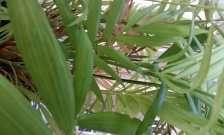The hunt for botanicals

Herbal medicine can be a double-edged sword and should be more rigorously investigated for both its beneficial and harmful effects, say researchers writing in a special supplement of Science.
Co-written by King's College London experts, the article reviews botanicals that have shown promising results in treating fibrosis or tissue scarring, along with some other herbs that are associated with pro-fibrotic damage to the liver, the kidney and some other organs.
Around 45% of deaths in the US can be attributed to fibrotic diseases such as systemic sclerosis, cardiovascular disease, liver cirrhosis, lung fibrosis and progressive kidney disease. In fibrosis, normal healthy tissue is replaced by scar tissue, which in turn often leads to chronic organ failure. For many of these chronic conditions no cure currently exists, despite progresses in understanding the mechanisms of fibrosis and pinpointing a number of possible drug targets and anti-fibrotic drug leads.
The only anti-fibrotic drug currently registered in Europe and the US, pirfenidone, has shown some beneficial effects in patients with idiopathic pulmonary fibrosis and fibrotic kidney diseases, but its clinical efficacy on fibrosis remains equivocal. A number of herbal medicinal products such as those used in traditional Chinese medicine have been reported to have some effect on fibrosis, but robust scientific evidence of these botanicals as safe and effective anti-fibrotic therapeutics is lacking.
Silymarin, a mixture of flavolignans from milk thistle, has been used to treat chronic liver diseases worldwide. Fuzheng Huayu, a formula widely used in China to prevent and reverse liver fibrosis, has recently completed a Food and Drug Administration (FDA)-approved trial.
Recent studies at King's have investigated the anti-fibrotic activities of a number of herbal products in the laboratory, including Fuzheng Huayu and Salvia miltiorrhiza root (SMR), a main component of Fuzheng Huayu. A separate systematic review of clinical treatments of chronic hepatitis B identified SMR and its extracts as being among the top five herbal entities reported to have the most potent anti-fibrotic activities.
In contrast, some botanicals have been implicated in causing fibrosis. In clinical reports from Beijing and Shanghai, for example, herbs were reported to account for 21-54% of drug-induced liver injury. Herbs have also been reported to be associated with fibrosis of the heart and kidney.
Kidney fibrosis is known to be induced by some Aristolochia taxa and other plant species containing aristolochic acids (AAs). Previously used medicinally in a number of countries, AA-containing plants are now recognized as a worldwide health threat and banned in most Western countries due to their association with urinary malignancies and AA nephropathy (kidney disease), including Balkan endemic nephropathy, which results from eating grains contaminated by Aristolochia seeds.
Around one-third of the Taiwanese population consumed AA-containing herbs between 1997 and 2003, and AAN previously accounted for up to 10% of all cases of end-stage renal failure in Taiwan. The banning of AA-containing herbs, together with other efforts such as public-awareness campaigns, education of patients, funding for research into chronic kidney disease and provision of integrated care, has turned Taiwan into one of the few regions where the rise in the number of cases of end-stage renal failure has been curbed.
Dr Qihe Xu, Senior Lecturer in Renal Medicine at King's College London and first author of the article, says: "Fibrosis is a leading cause of mortality. This pressing challenge must be addressed through robust strategies, by developing efficacious anti-fibrotics and by preventing exposure to fibrogenic compounds. Given the contradictory and complex roles botanicals play in fibrotic diseases, there is an urgent need for studies to investigate the efficacy, safety and good practices for botanical-based remedies."
Professor Peter Hylands, Head of the Institute of Pharmaceutical Science at King's and senior author of the article, says: "Because evidence-based medicine is a relatively new concept in many countries, many clinical reports on herbal treatment of fibrotic diseases have been criticized as being of poor quality. At present, with funding insufficient to establish and maintain good practice, botanical research is generally perceived to be a risky area, but there are also risks if we disregard anti- and pro-fibrotic botanicals. Thus, we call for sustainable investment into this challenging but increasingly important research field to encourage innovation and good practice."
More information: 'The hunt for anti-fibrotic and pro-fibrotic botanicals' by Qihe Xu, Yibin Feng, Pierre Duez, Bruce Hendry and Peter Hylands is published in a special supplement of the journal Science, The Art and Science of Traditional Chinese Medicine, on Friday 19 December 2014. www.sciencemag.org/site/produc … _high_resolution.pdf



















